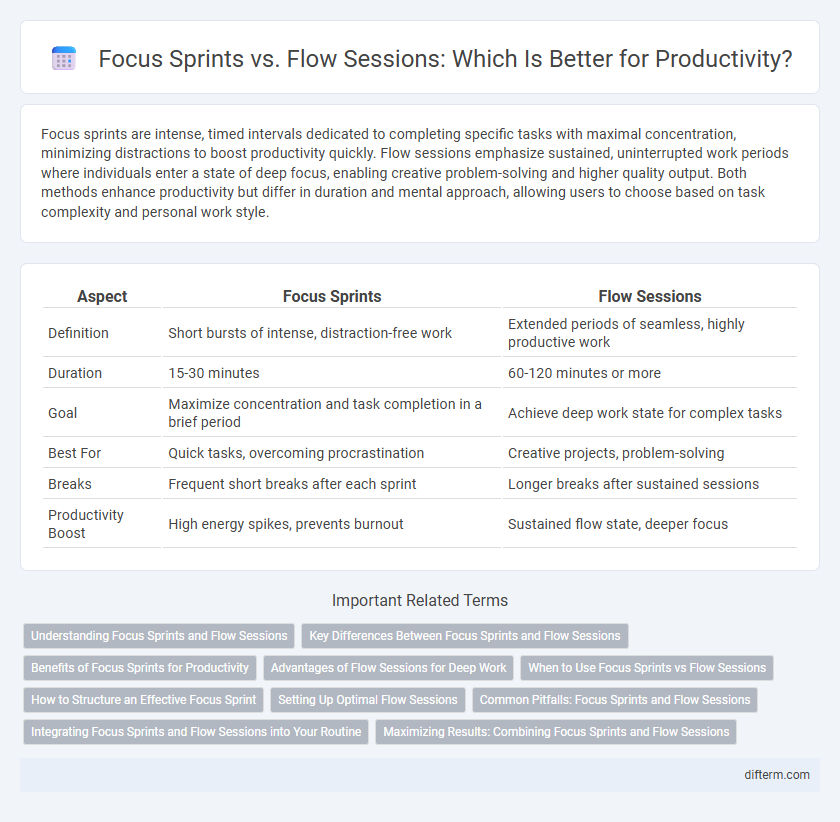Focus sprints are intense, timed intervals dedicated to completing specific tasks with maximal concentration, minimizing distractions to boost productivity quickly. Flow sessions emphasize sustained, uninterrupted work periods where individuals enter a state of deep focus, enabling creative problem-solving and higher quality output. Both methods enhance productivity but differ in duration and mental approach, allowing users to choose based on task complexity and personal work style.
Table of Comparison
| Aspect | Focus Sprints | Flow Sessions |
|---|---|---|
| Definition | Short bursts of intense, distraction-free work | Extended periods of seamless, highly productive work |
| Duration | 15-30 minutes | 60-120 minutes or more |
| Goal | Maximize concentration and task completion in a brief period | Achieve deep work state for complex tasks |
| Best For | Quick tasks, overcoming procrastination | Creative projects, problem-solving |
| Breaks | Frequent short breaks after each sprint | Longer breaks after sustained sessions |
| Productivity Boost | High energy spikes, prevents burnout | Sustained flow state, deeper focus |
Understanding Focus Sprints and Flow Sessions
Focus sprints are structured work intervals, typically lasting 25 to 50 minutes, designed to maximize concentration and minimize distractions through intense, time-boxed effort. Flow sessions involve longer periods of deep work where individuals achieve a state of immersion and sustained productivity, often exceeding an hour without interruptions. Both methods enhance productivity by leveraging different cognitive rhythms, with focus sprints providing regular breaks to maintain alertness and flow sessions promoting uninterrupted work to achieve complex task mastery.
Key Differences Between Focus Sprints and Flow Sessions
Focus sprints are structured, time-boxed intervals designed to tackle specific tasks with maximum intensity, typically ranging from 25 to 50 minutes, while flow sessions emphasize prolonged engagement in complex activities to achieve deep work states lasting 90 minutes or more. The key differences lie in their approach: focus sprints prioritize short bursts of productivity to overcome distractions, whereas flow sessions cultivate sustained concentration by minimizing interruptions and facilitating a seamless cognitive rhythm. Both methods enhance productivity but cater to different task types and individual workflow preferences.
Benefits of Focus Sprints for Productivity
Focus sprints enhance productivity by enabling intense, short bursts of concentrated work, minimizing distractions and increasing task completion speed. These sprints improve cognitive stamina and reduce burnout through planned intervals and breaks. Tracking focus sprints also helps in measuring progress and maintaining consistent momentum on high-priority projects.
Advantages of Flow Sessions for Deep Work
Flow sessions enhance deep work by promoting sustained concentration and minimizing task-switching, which boosts cognitive efficiency and creativity. These sessions foster an immersive work state where distractions are eliminated, leading to increased output quality and problem-solving capacity. Regular flow sessions help build mental resilience, enabling longer periods of high productivity and mastery over complex tasks.
When to Use Focus Sprints vs Flow Sessions
Focus sprints are ideal for tackling high-priority, time-sensitive tasks that require intense bursts of concentration within short, defined timeframes, typically 25 to 45 minutes. Flow sessions suit complex, creative projects needing sustained mental engagement over longer periods without interruption, often extending beyond an hour. Choosing between focus sprints and flow sessions depends on task urgency, complexity, and the cognitive stamina required for optimal productivity.
How to Structure an Effective Focus Sprint
An effective focus sprint is structured by setting a clear, specific goal to be achieved within a short, fixed time frame, typically 25 to 45 minutes. Eliminate all distractions by turning off notifications, closing unrelated tabs, and informing others of your unavailability to maintain deep concentration. Incorporate brief breaks after each sprint to recharge cognitive resources and sustain high productivity throughout the work session.
Setting Up Optimal Flow Sessions
Setting up optimal flow sessions requires creating an environment free from distractions, using time-blocking techniques to allocate dedicated periods for deep work. Incorporating regular breaks following the Pomodoro technique enhances sustained concentration and cognitive performance. Tailoring session lengths to individual energy cycles maximizes productivity and maintains mental clarity throughout tasks.
Common Pitfalls: Focus Sprints and Flow Sessions
Focus sprints often suffer from burnout due to intensive, prolonged effort without adequate breaks, reducing overall productivity. Flow sessions face challenges such as frequent distractions and lack of clear goals, which disrupt deep work and diminish concentration. Overcoming these pitfalls requires structured time management and minimizing interruptions to sustain high performance.
Integrating Focus Sprints and Flow Sessions into Your Routine
Integrating focus sprints and flow sessions into your routine enhances productivity by balancing intense bursts of concentration with sustained creative immersion. Focus sprints, typically lasting 25-45 minutes, maximize task-specific efficiency, while flow sessions extend beyond to foster deep work and problem-solving. Structuring your day around these techniques supports mental clarity, reduces burnout, and improves task completion rates.
Maximizing Results: Combining Focus Sprints and Flow Sessions
Maximizing productivity involves leveraging the structured intensity of focus sprints alongside the sustained engagement of flow sessions to optimize cognitive performance. Focus sprints, characterized by short bursts of concentrated work, enhance task initiation and momentum, while flow sessions, typically longer and uninterrupted, deepen immersion and creative problem-solving. Integrating both methods enables balancing rapid progress with deep focus, driving superior results in complex projects and knowledge work.
Focus sprints vs Flow sessions Infographic

 difterm.com
difterm.com